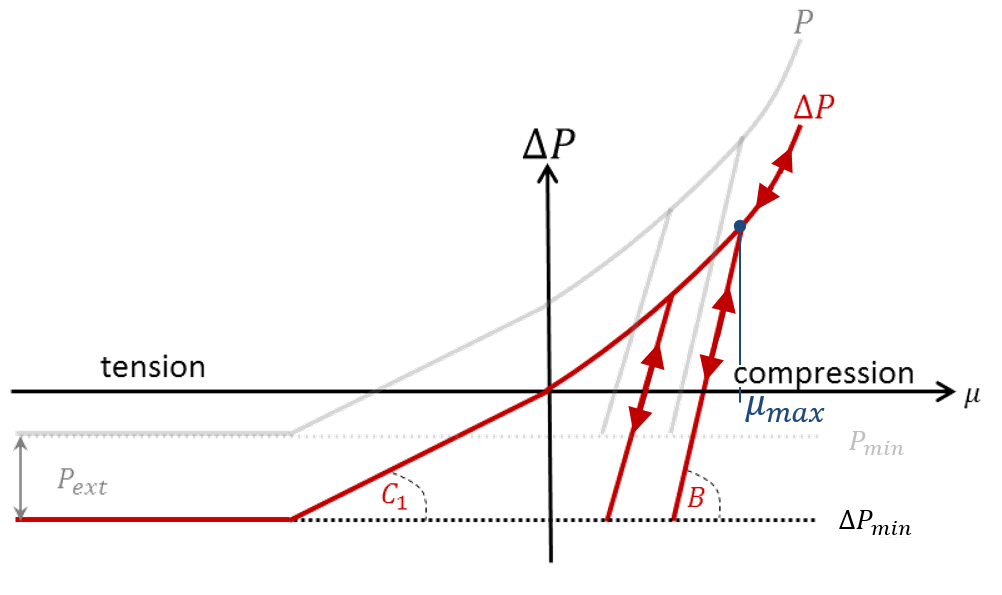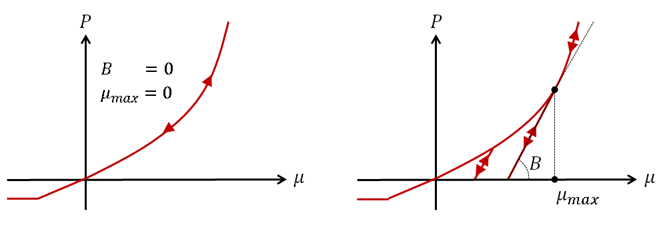/MAT/LAW21 (DPRAG)
Block Format Keyword This law, based on Drucker-Prager yield criteria, is used to model materials with internal friction such as rock-concrete. The plastic behavior of these materials is dependent on the pressure in the material.
Format
| (1) | (2) | (3) | (4) | (5) | (6) | (7) | (8) | (9) | (10) |
|---|---|---|---|---|---|---|---|---|---|
| /MAT/LAW21/mat_ID/unit_ID or /MAT/DPRAG/mat_ID/unit_ID | |||||||||
| mat_title | |||||||||
| E | |||||||||
| A0 | A1 | A2 | Amax | ||||||
| fct_IDf | Kt | FscaleP | |||||||
| Pext | |||||||||
| B | |||||||||
Definition
| Field | Contents | SI Unit Example |
|---|---|---|
| mat_ID | Material
identifier (Integer, maximum 10 digits) |
|
| unit_ID | Unit Identifier (Integer, maximum 10 digits) |
|
| mat_title | Material
title (Character, maximum 100 characters) |
|
| Initial
density (Real) |
||
| E | Young's
modulus (Real) |
|
| Poisson's
ratio (Real) |
||
| A0 | Material plasticity
coefficient. (Real) |
|
| A1 | Material plasticity
coefficient. (Real) |
|
| A2 | Material plasticity
coefficient. (Real) |
|
| Amax | Limiting von Mises
stress. Default set to 1030 (Real) |
|
| fct_IDf | Function identifier
describing
. (Integer) |
|
| Kt | Tensile bulk modulus.
3 (Real) |
|
| FscaleP | Pressure function scale
factor. Default = 1.0 (Real) |
|
| Minimum
pressure. Default = -1030 (Real) |
||
| Pext | External pressure. 4 Default = 0 (Real) |
|
| B | Unloading bulk modulus.
3 (Real) |
|
| Maximum volumetric strain
in compression. 5 (Real) |
Example (Sand)
#RADIOSS STARTER
#---1----|----2----|----3----|----4----|----5----|----6----|----7----|----8----|----9----|---10----|
/UNIT/1
unit for mat
Mg mm s
#---1----|----2----|----3----|----4----|----5----|----6----|----7----|----8----|----9----|---10----|
#- 2. MATERIALS:
#---1----|----2----|----3----|----4----|----5----|----6----|----7----|----8----|----9----|---10----|
/MAT/DPRAG/1/1
Sand
# Init. dens.
1.6E-9
# E Nu
100 .3
# A0 A1 A2 Amax
1E-7 .001 1 0
# If Kt Fscale
2 1 0
# P_min
-1.5E-4
# B Mu_max
80 .4
#---1----|----2----|----3----|----4----|----5----|----6----|----7----|----8----|----9----|---10----|
#- 3. FUNCTIONS:
#---1----|----2----|----3----|----4----|----5----|----6----|----7----|----8----|----9----|---10----|
/FUNCT/2
Sand
# X Y
-1 0
0 0
.1 1000
.2 2500
.3 5000
.4 10000
#---1----|----2----|----3----|----4----|----5----|----6----|----7----|----8----|----9----|---10----|
#ENDDATA
#---1----|----2----|----3----|----4----|----5----|----6----|----7----|----8----|----9----|---10----|Comments
- Hydrodynamic behavior is given by a
user-defined function
.Where,
- P
- Pressure in the material
- Volumetric strain with

Figure 1. - Drucker-Prager yield criteria uses a
modified von Mises yield criteria to incorporate the effects of pressure for
massive structures:
(1) 
Figure 2.Where,- Second invariant of deviatoric stress, with
- P
- Pressure, with ( is the first stress invariant)
- A0, A1, and A2
- Material plasticity coefficients
- Yield criteria is von Mises ( )
- It is recommended to set Unloading Bulk modulus, B is equal to the initial slope of function describing and Tensile Bulk modulus Kt equal to 1/100 of Unloading Bulk modulus B and Kt must be positive.
- External pressure is needed in
case of relative pressure formulation. In this specific case, yield criteria and
energy integration require total pressure value. Radioss outputs a pressure which is relative to
. You can conclude the total pressure value
from:
(2) Total pressure limit is concluded from:(3) If , the output result is a total pressure:
and
- B is
unloading bulk modulus. If B is defined, then it must be greater
than any slope
in
.
- If and , the unloading and loading paths are the same.
- If or , the default value for B is .
- If or , the default value for is .

Figure 3.